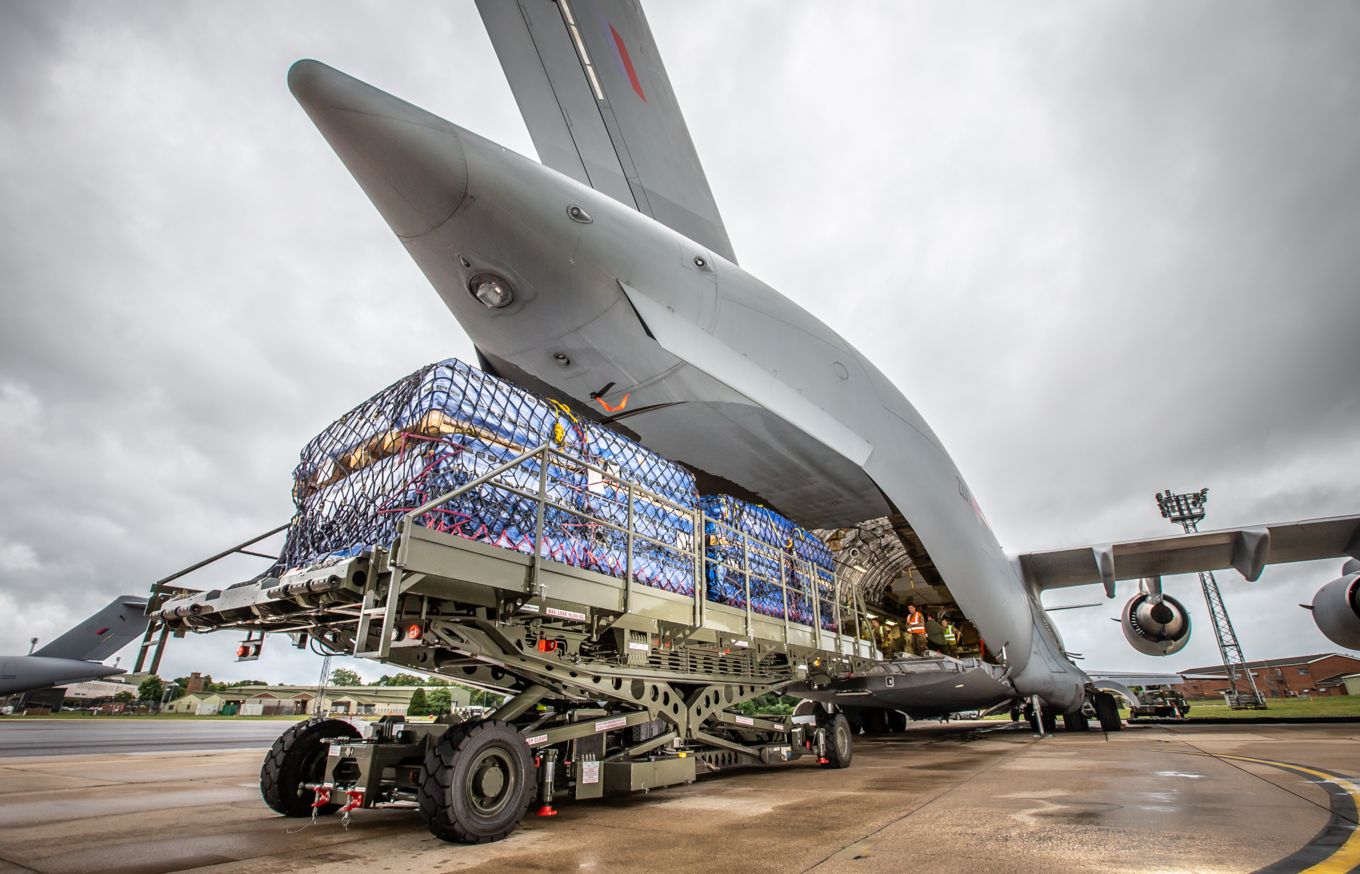A Royal Air Force C-17 cargo aircraft departed for Accra, Ghana on Saturday carrying materials for the construction of a field hospital.
NATO say that this facility will be used for frontline aid workers in the region, to help fight the coronavirus pandemic.
According to a Royal Air Force news release on the topic:
“Operated by 99 Squadron, the C-17 Globemaster is the RAF’s long-range, heavy-lift strategic transport aircraft that can operate close to a potential area of operations for combat, peacekeeping or humanitarian missions worldwide.”
The UK flight comes in response to a request by the United Nations (UN) to NATO’s Euro-Atlantic Disaster Response Coordination Centre (EADRCC).

“The UN used this mechanism to call for NATO Allies’ help in transporting urgently needed medical items. With commercial flights disrupted and the cost of cargo flights having escalated, this support comes at a crucial time.”
“NATO Allies are working together to address the COVID-19 pandemic, and to support our partners. Last month, NATO agreed to support the UN’s global call for airlift assistance. I warmly welcome that the United Kingdom is the first NATO Ally to come forward with an aid flight, delivering supplies to build a field hospital in Ghana. This is a concrete demonstration of solidarity in action – NATO Allies stepping up to save lives,” said NATO Secretary General Jens Stoltenberg.
International Development Secretary Anne-Marie Trevelyan said:
“These flights will play a crucial role in the global battle against coronavirus, helping to stop the spread of the disease globally. Aid workers are on the frontline of the coronavirus response, and it is critical they are protected so they can continue their life-saving work. This is the best of British – the UK military and UK aid – working together to solve a global problem for the benefit of all of us. No one is safe until we are all safe.”
The aircraft is the first in a series of Royal Air Force flights transporting supplies for the construction of a UK aid funded field hospital on behalf of the World Food Programme (WFP), which is handling infrastructure and logistics on behalf of the UN, say the organisation.
NATO say that the field hospital weighs approximately 130 tonnes and will have the capacity to care for up to 92 people. It will be transported to Accra in approximately five flights over the coming weeks, say the Royal Air Force.














Big lifts are what the C17’s are about…good to see them in action. Need a couple ,more from US storage though (or 4)!
What C17 in US storage?
There are certainly none in inventory at AMARG. Now production has ended there are no C17 going spare.
Yes, we did well expanding our fleet to 8 from the 4 leased examples.
I think India secured the last two off the production line.
Great effort, and a perfect demonstration of this countries world beating soft power, and to help others far less fortunate then ourselves. ??????
Will they publish the accounts to show DFID money going to the RAF budget for the flights?
Now, if only we had a hybrid hospital ship or four able to sail there as well to really boost through-put of casualties.
It’s the Foreign, Commonwealth and Development Office now.
Or the FO for short 😉
Not quiet yet! A few months to go.
Two hospital ships at least. Hopefully FO will now do something about it. Now we need a boost to manufacturing that this will create and will benefit abroad (and locally) too. NI or England yard, as Scotland have all the other warships in the pipe. Can we also throw in an order for a couple of marlins per ship as well (painted white) and maybe a dedicated AM400 flying hospital? Or is this too much of a pipe dream 🙁
Lets hope the cost comes out the aid budget or from the UN
Maybe paint a flag on it too.
Yes, the aid budget please. We should be told!
Did anyone see the images of a bird strike on the A400? It ripped a hole in the fuselage below the cockpit. Thats not very reassuring!
Bearded Vulture apparently, they weigh between 5kg and 7.5kg and have an average wingspan of 2.5m
Rare bird. As with much of the situation with endangered wildlife each individual loss is of serious concern
Even rarer bird now!
Points for black humour Steve 🙂 Here in SA, the Bearded vulture is confined to the Drakensberg and there are less than 100 breeding pairs surviving. in general all our Vulture species are endangered particularly as they are used as “Muthi”(potions) by Witch doctors. Many are killed en masse by deliberately poisoned carcasses left out in their habitat.
What a piece of work is man…
Odd the way it bounced off the fuselage and then penetrated further along. Suggests that it bounced off and then was sucked back into the boundary layer. Really weird that it broke through close to the reinforced penetration as well – sort of suggests that the design of that penetration isn’t that great.
I’m also more than surprised that these images, particularly the internal ones, have been made public.
Where was it published?
Good work.